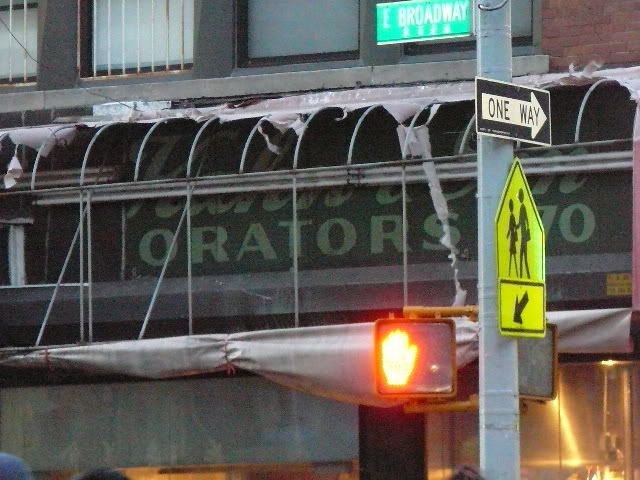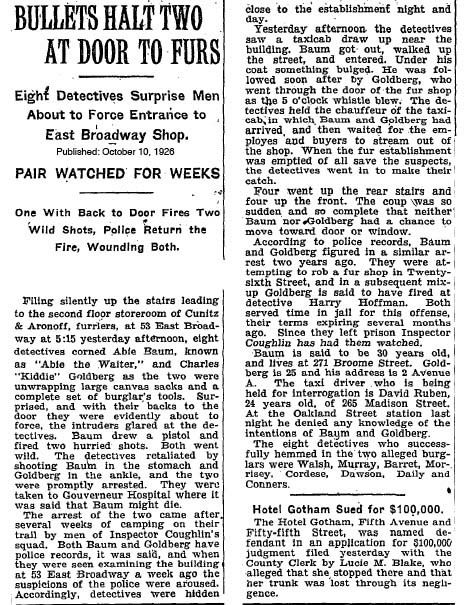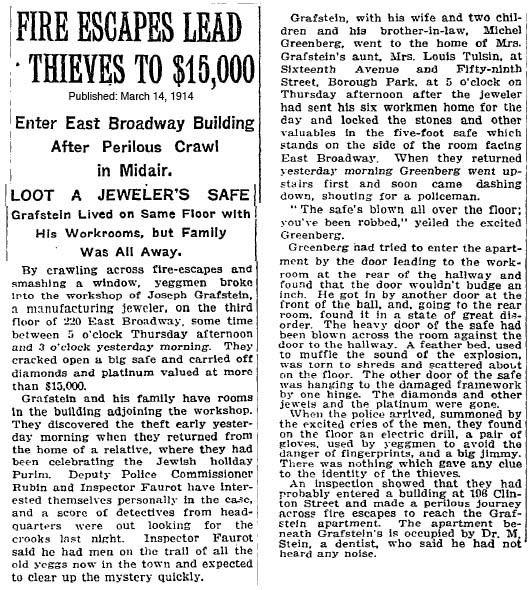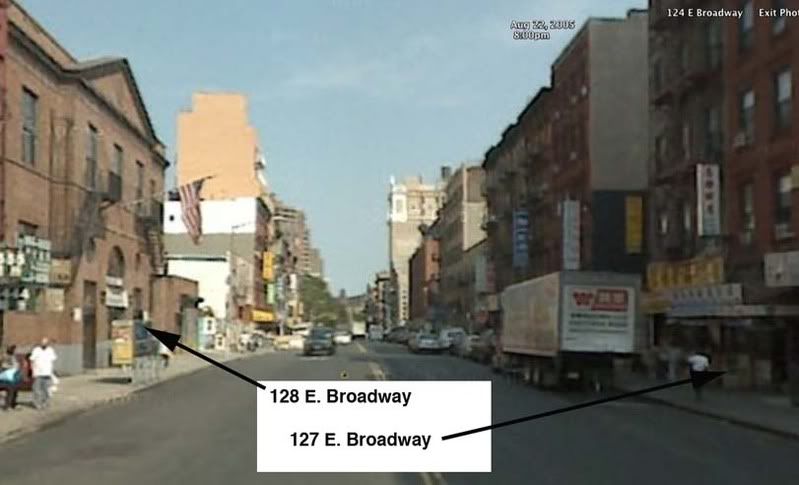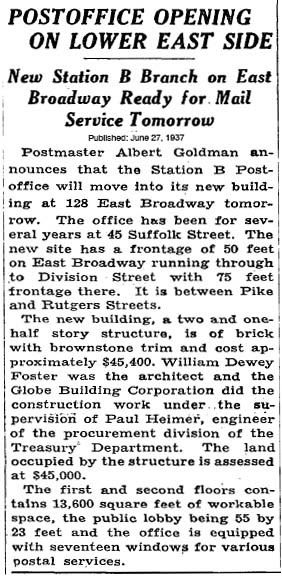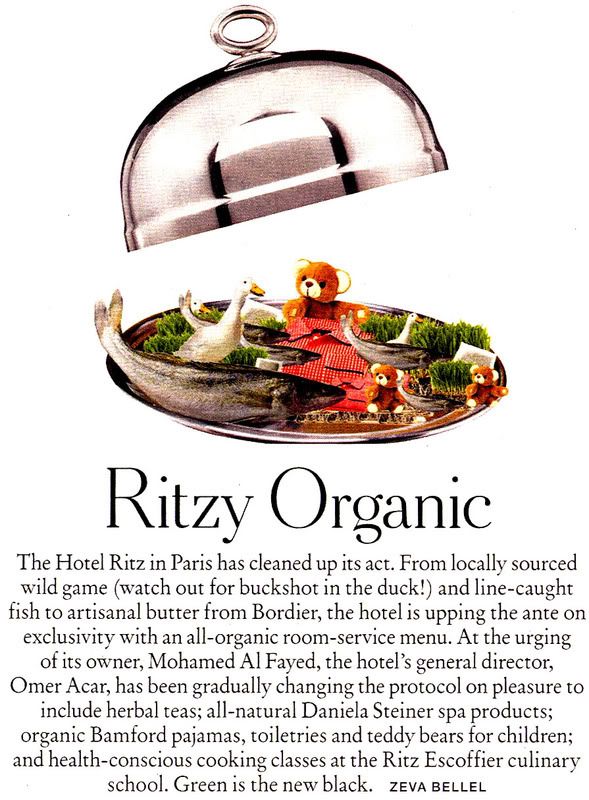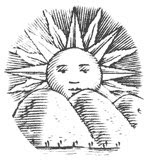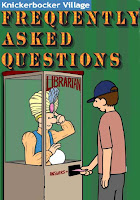I put together a compilation of images of Lansky in addition to his locations on the LES
Saturday, May 31, 2008
Who's Almost Who In Knickerbocker Village History: Meyer Lansky
I always thought Meyer's LES roots were further "uptown" than they really were. According to the following, part of a recent Lost and Found entry by the Times' James Stevenson, he lived at 546 Grand Street (now part of the Grand Street Co-ops) and went to school at the old PS 34 on Broome Street.
Read this doc on Scribd: lansky
Haber's Decorator's: 70 East Broadway
Changing East Broadway
Why so much crime on East Broadway? By the end of the 19th Century, the block was transformed from a residential block to a commercial one.
Read this doc on Scribd: east-bdway
1937: Knickerbocker Branch Post Office Opens
127 East Broadway Theft, 1898
from the nytimes' October 9, 1898. Relatives of Larry and Lee Levy? :)
Read this doc on Scribd: jennie-levy
KV Baby Boom Basketball Memories
With the Celtics facing the Lakers in the NBA Championship Series it reminded me of my first recollections of watching basketball. I have to admit that I wasn't a Knicks' fan, but a Celtics' one instead. It was Bob Cousy who grabbed my attention along with the great team play that his passing and ball handling skills enabled. Above some film clips I found that I combined with an NPR interview about the Russell-Chamberlain rivalry. It was highlighted in John Taylor's book, "The Rivalry: Bill Russell, Wilt Chamberlain, and the Golden Age of Basketball."
About Cousy
Robert Joseph "Bob" Cousy (born August 9, 1928 in New York City) is a former French-American professional basketball player. The 6'1" (1.85 m), 175 pounds (79.4 kg) Cousy played point guard with the National Basketball Association's (NBA) Boston Celtics from 1951 to 1963 and briefly with the Cincinnati Royals in the 1969--70 season. In his first 11 seasons in the NBA, Cousy led the league in assists eight consecutive times and introduced a new blend of ball-handling and passing skills, earning him the nicknames "The Cooz" and "Houdini of the Hardwood". He was elected into the Basketball Hall of Fame in 1971, and in his honor, the Celtics retired his number 14 jersey and hung it into the rafters of the Boston Garden, where it has remained since. Cousy was named to the NBA 25th Anniversary Team in 1971, the NBA 35th Anniversary Team in 1981, and the NBA's 50th Anniversary All-Time Team in 1996, making him one of only four players that were selected into all those teams. In the 1959-60 NBA season, Cousy was again productive, his 19.4 points, 4.7 rebounds and 9.5 assists per game earning him his eighth consecutive assists title and another joint All-NBA First Team and All-Star team nomination. Again, the Celtics defeated all opposition and won the 1960 NBA Finals 4--3 against the Hawks. A year later, the 32-year-old Cousy scored 18.1 points, 4.4 rebounds and 7.7 assists per game, winning another pair of All-NBA First Team and All-Star nominations.
About the NPR interview
When a young Wilt Chamberlain was to face off against Boston Celtics center Bill Russell for the first time in 1959, one magazine billed it "The Big Collision." Author John Taylor writes about that collision's effects and the early days of professional basketball in The Rivalry: Bill Russell, Wilt Chamberlain, and the Golden Age of Basketball. Taylor talks with Scott Simon about the book.
Excerpt: Chapter One
ON THE NIGHT of November 7, 1959, people lined up on the sidewalks outside Boston's North Station, a dingy yellow-brick building, and crowded along the bar at the Iron Horse, the old drinking-parlor inside. They stood in clusters on Causeway Street and Haverhill Street and Canal Street, their voices almost drowned out by the thundering traffic on the elevated highways and subway tracks that crossed above them on iron girders, and by the hiss and clang of the trains in the rail yards.
The citizens of Boston had much to debate that evening. In Washington, D.C., Charles Van Doren, the thirty-three-year-old Columbia University English professor, had just admitted to a congressional committee that the producers of Twenty-One, the television quiz show that had turned him into a national icon, had been secretly prepping him with the answers to questions. Senator John Kennedy, who had all but announced his intention to run for president the following year, had been touring California and Oregon the previous week, greeted by ecstatic crowds carrying signs saying "Viva Kennedy!" In Boston itself, a newspaper strike was under way, and just four days earlier, John Collins, the Suffolk County register of probate and a victim of paralytic polio who was confined to a wheelchair, had defeated Senate president John Powers for the Boston mayoralty. It was a stunning upset, brought about by an FBI raid on the headquarters of a gambling syndicate just one hundred yards from the East Boston police station and resulting in charges of widespread corruption in the city's government.
But the topic that consumed the crowds around North Station was neither the television scandal nor the impending administration of John Collins nor the presidential prospects of a young Irish American Catholic. It was instead basketball, specifically the game scheduled that night between the Boston Celtics and the Philadelphia Warriors. While Boston was a storied sports town, the sports that had always provoked the most passion were baseball and hockey, the sports of the Red Sox and the Bruins. These were sports with rich local histories, sports that had been played for generations in Boston and had, over the years, woven themselves so deeply into the fabric of the city that residence there seemed virtually synonymous with a rabid devotion to its baseball and hockey teams. Professional basketball, in contrast, was only thirteen years old in 1959. Walter Brown, the owner of the Bruins and leaseholder on the Boston Garden, had started the Celtics to fill seats at the arena on nights when his beloved hockey team was not playing and the big, drafty building, located above the train station, would otherwise sit dark and empty. In other words, the team was a purely commercial afterthought in a sport without strong roots in the city's culture, and for much of the fifties, attendance at its games reflected this. Rarely was the Garden more than half filled on the nights it played. Members of the Celtics joked that while Ted Williams could not get out of a car on Charles Street without being mobbed, their entire team could walk the length of the Common and no one would give them a second glance.
Lower East Side Tour: Jerry Stiller
The bialystoker thread reminded me that I had this slide show from several years ago that I never posted. It featured part of an audio tour that Jerry Stiller did. I tried to match it with images, May of the images came from a LES tour that some students from the Fieldston school in Riverdale took. The last pics are from the "bialy capital" of the world, Kossars on Grand Street.
A History Of The Bialystoker Home
from a bialystoker history site
on page 12 of the pdf Sam Mines is mentioned. He's the great grandfather of my daughter Zeva Bellel. The NYC real estate Ratner family are Bialystoker's
on page 12 of the pdf Sam Mines is mentioned. He's the great grandfather of my daughter Zeva Bellel. The NYC real estate Ratner family are Bialystoker's
Read this doc on Scribd: bialystoker-home
The Opening Of The Bialystoker Home
Just one month before the stock market crash
Read this doc on Scribd: bialy-home
Thursday, May 29, 2008
Nostalgia
Every city has its old neighborhoods and just about everyone has that desire at some point in their life to reconnect with that neighborhood. I discovered some "Knickerbocker-like" (Jewish versions) similarities in the history of the Northern Liberty neighborhood of Philadelphia. Th excerpts are from the book "The Jewish Community Around North Broad Street," By Allen Meyers
Read this doc on Scribd: north-philly
Northern Liberty (Philadelphia) Greenery
An interesting neighborhood in Philadelphia that my family explored over Memorial Day.
I have some Philly roots on my mother's side
A highlight (besides the snoozing cat in the window) was the food at Honey's Sit & Eat on 800 North Fourth Street
This American Southern and Jewish fusion restaurant is a paradise for vegetarians and health-conscious individuals. It features tofu, veggie sausages, free-range eggs, organic fair trade coffees, and locally-grown produce. The dinner menu is equally good with a BYOB policy and items such as Honey’s homemade veggie burger and Honey fried chicken fingers served with scallion hushpuppies. The décor is country kitchen: hard wood floors, light green walls trimmed with flowered wallpaper and adorned with old-fashioned photos, accessorized with red and white checkered lamps. Excellent service, fantastic food, fresh ingredients, and a relaxing atmosphere are the reasons why Honey’s takes top honors in the city of brotherly love.
Mountain Greenery by Pennsylvania's own Perry Como
Slumming In New York: The Fourth Ward 2
A slide show made up of Jacob Riis' photos. a youtube source but I replaced the soundtrack. Instead I added "Brooklyn Heights" from "Gangs of New York"
Slumming In New York: The Fourth Ward
Who's Almost Who In Knickerbocker Village History: Karen Delgado
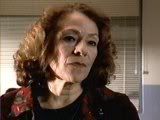 I found out about Karen Delgado from Nancy Bayer (Bueller). Karen attended Seward Park High School with Nancy. That's Karen on the left in the role of Carmen Alvarez on "Oz"
I found out about Karen Delgado from Nancy Bayer (Bueller). Karen attended Seward Park High School with Nancy. That's Karen on the left in the role of Carmen Alvarez on "Oz" Read this doc on Scribd: delgado
Wednesday, May 28, 2008
Rheba Liebowitz
No one knows the exact reason that Rheba has garnered this honor. It's not likely it's because she was the wife of Harry Liebowitz, LMRC's manager, but for many of us who played for him that would be suffice
Read this doc on Scribd: rheba2
Delancey-Essex-Grand-Norfolk-Broome Panoramic Scene
Crossing Delancey was shown outdoors on 5/17/08 in the parking lot on Broome and Norfolk. It was an event sponsored by the LES Business Improvement District.
This panoramic scene connects three panoramic movies: a panoramic movie taken at the intersection of Grand and Essex, a panoramic movie taken of Essex looking North to Delancey, and a panoramic movie of the film site in a parking lot at Broome and Norfolk. Look for the hot spots that link one movie to another.
This panoramic scene connects three panoramic movies: a panoramic movie taken at the intersection of Grand and Essex, a panoramic movie taken of Essex looking North to Delancey, and a panoramic movie of the film site in a parking lot at Broome and Norfolk. Look for the hot spots that link one movie to another.
Who Put The Bop
to settle a recent question posed on the KV email list, it wasn't Barry Mann and Gerry Goffin as listed in Wikipedia (as I wrongfully stated at first), but George Jones Jr. of the Edsel's, Born 5 October 1936, Youngstown, Ohio
from rockabillyeurope
So who put the Ram in the Rama Lama Ding Dong, making Barry Mann's baby fall in love with him? It was George Jones, Jr., the lead singer of the Edsels, who wrote the song while in the air force. The Edsels were a quintet from Campbell, Ohio, near Youngstown, formed in 1957. George Jones, Jr (lead), Larry Green (first tenor), James Reynolds (second tenor), Harry Green (baritone and Larry's brother) and Marshall Sewell (bass) were originally the Essos. They changed their name from gas to a car when Ford's Edsel came out. The group auditioned for Jim Manderitz, a local music publisher, who was so impressed he whipped out a contract and signed them on the spot. They recorded "Rama Lama Ding Dong" at Snyder Studios in Cleveland and Manderitz began searching out every label he could find, but alas, there were no takers. Finally, he came upon Foster Johnson and his new Dub label in Little Rock, Arkansas. The record came out in July 1958, only Foster Johnson had changed the title on the label to "Lama Rama Ding Dong". Regardless, the record never got a notice except for some initial action in Baltimore. Their next two releases were R&B ballads, "Do You Love Me" on Roulette (1959) and "What Brought Us Together" on Tammy (1960), which took off locally and spread enough for the group to get its first taste of the road and a spot on "American Bandstand". Before the Edsels could record a follow-up, their follow-up was chosen for them. When the Marcels hit it big with "Blue Moon", one disc jockey in New York remembered a record from a few years before that was in the same style, had a similarly wacky intro and would segue beautifully out of "Blue Moon". The record? "Lama Rama Ding Dong". He started playing it and the phones lit up like a Christmas tree. When Jim Manderitz heard all the commotion about his record, he licensed it to Hy Weiss of the Old Town conglomerate, who reissued it on the Twin label. By May 1, 1961, it charted and began selling all over the USA, reaching # 21. However, Foster Johnson in Little Rock had sold all his stock and master tapes to a cut price wholesaler in Hollywood, who repressed the record on a phony Dub label, inadvertently using a different, slightly faster take, thus creating a bootleg with a difference. Manderitz had two sides left in the can that he now sold to Dot Records, while Tammy licensed two more sides to Ember and suddenly Edsel masters were selling in larger quantities than Edsel cars. Neither of these singles, nor three more 45s for Capitol, did much and after two further unsuccessful issues on Tammy in 1963, the group decided to call it quits. George Jones continued to sing, joining the Winston Wall Trio and then New Affair. According to Joel Whitburn's "Top Pop Singles 1955-1999", he is now deceased, but I found no further evidence of his passing and there is no entry for him in the Social Security Death Index.
Tuesday, May 27, 2008
Merchant's Concourse Panoramic Movie
A panoramic movie of one of the parking lots in the Merchant's Concourse Shopping Center in Hempstead, Long Island. Featured are Target's and Famous Dave's
Merchant's Concourse Greenery
#11 in the May "Greenery" series. Visual highlights include Target and Famous Dave's BBQ. Several ex KVer's live in close proximity to this shopping mecca in Nassau County
Mountain Greenery soundtrack from
2 March 1967 (Season 1, Episode 20)
Salute to the songs of Richard Rodgers and Lorenz Hart. All music program with no spoken dialogue. Songs include:
I Could Write A Book / The Lady Is A Tramp / Little Girl Blue / I Wish I Were In Love Again - Bobby Darin, Falling in Love With Love - Bobby Darin and The Supremes, Lover / With a Song in My Heart / My Romance / Blue Moon / Manhattan - The Supremes, Where or When / Thou Swell / Spring is Here / On Your Toes - Petula Clark, Any Old Place with You - Darin and Clark, My Heart Stood Still / Glad to Be Unhappy / Here in My Arms / Sing for Your Supper - The Mamas and the Papas, Slaughter on Tenth Avenue - The Doodletown Pipers with Count Basie and His Orchestra, Dancing on the Ceiling / Give It Back to the Indians - Peter Gennaro, Johnny One Note -Peter Gennaro with Count Basie and His Orchestra, Wait till You See Her - The Doodletown Pipers, Mountain Greenery - Cast. Quincy Jones was the musical director.
Chip Off The Old Block Humor: "Are The Horses Still Working?"
This follows the humorous story Ron told abut his dad in a previous post
from the 8/26/03 Downtown Express
from the 8/26/03 Downtown Express
Read this doc on Scribd: blackout humor
Perry Como: Catch A Falling Star, 1958
Catch a falling star an’ put it in your pocket,
Never let it fade away!
Catch a falling star an’ put it in your pocket,
Save it for a rainy day!
For love may come an' tap you on the shoulder,
Some star-less night!
Just in case you feel you wanna’ hold her,
You’ll have a pocketful of starlight!
Catch a falling star an’ ( Catch a falling . . . ) put it in your pocket,
Never let it fade away! ( Never let it fade away! )
Catch a falling star an’ ( Catch a falling . . . ) put it in your pocket,
Save it for a rainy day! ( Save it for a rainy day! )
For love may come and tap you on the shoulder,
Some star-less night!
An’ just in case you feel you wanta’ hold her,
You’ll have a pocketful of starlight!
( . . . pocketful of starlight! ) [ hum in time ]
Catch a falling star an’ ( Catch a falling . . . ) put it in your pocket,
Never let it fade away! ( Never let it fade away! )
Catch a falling star an’ ( Catch a falling . . . ) put it in your pocket,
Save it for a rainy day! ( Save it for a rainy . . . Save it for a rainy, rainy rainy day! )
For when your troubles startn’ multiplyin’,
An' they just might!
It’s easy to forget them without tryin’,
With just a pocketful of starlight!
Catch a falling star an’ ( Catch a falling . . . ) put it in your pocket,
Never let it fade away! ( Never let it fade away! )
Catch a falling star an’ put it in your pocket,
Save it for a rainy day!
( Save it for rainy day! ) Save it for a rainy day!
Words and Music by Lee Pockriss and Paul Vance
Monday, May 26, 2008
Why A Duck?
A few posts ago KVers discussed the humor of their fathers. The above was some of the humor that those fathers grew up on. Eighty years later and it's hard to imagine anything as funny. Sort of topical with the value of real estate nose diving. There's
a quack at Bronx High of Science that also triggered the memory of this routine.
A transcript of some of the routine
HAMMER: Do you know what a lot is?
CHICO: Yeah, itsa too much.
HAMMER: I don't mean a whole lot. Just a little lot with nothing on it.
CHICO: Any time you gotta too much, you gotta whole lot. . .
HAMMER: Come here, Rand McNally and I'll explain this thing to you. Now look, this is a map and diagram of the whole Cocoanut section. . .Here's Cocoanut Manor. Here's Cocoanut Heights. That's a swamp; right over there where the road forks, that's Cocoanut Junction.
CHICO: Where have you got Cocoanut Custard?
HAMMER: Why, that's on the forks. You probably eat with your knife, so you wouldn't have to worry about that. . .Now, here's a little peninsula, and here is a viaduct leading over to the mainland.
CHICO: Why a duck?
HAMMER: . . .I say, here is a little peninsula, and here's a viaduct leading over to the mainland.
CHICO: All right. Why a duck?
HAMMER: I'm not playing Ask-Me-Another. I say, that's a viaduct.
CHICO: All right. Why a duck? Why a--why a duck? Why-a-no-chicken?
HAMMER: I don't know why-a-no-chicken. I'm a stranger here myself. All I know is that it's a viaduct. You try to cross over there a chicken, and you'll find out why a duck. It's deep water, that's viaduct.
CHICO: That's why a duck?
HAMMER: Look! Suppose you were out horseback riding and you came to that stream and wanted to ford over there. You couldn't make it. Too deep.
CHICO: But what do you want with a Ford when you gotta horse?
HAMMER: I'm sorry the matter ever came up. All I know is that it's a viaduct.
CHICO: Now look. . .all righta. . .I catcha on to why0a-horse, why-a-chicken, why-a-this, why-a-that. I no catch on to why-a-duck.
HAMMER: I was only fooling. They're going to build a tunnel in the morning. Now, is that clear to you?
CHICO: Yes, everything---except why-a-duck. . .
HAMMER: And then, there's a little clearing there, a little clearing around it. You see that wire fence there?
CHICO: All right. Why-a-fence?
HAMMER: Oh no. We're not going to go all through that again!
Saturday, May 24, 2008
City Hall Greenery
Another installment (10 so far) of my "month of may mountain greenery series." I'm running out of soundtracks. This one is by Tony Bennett. Not all of them are on Knickerbocker Village, the complete collection is on my pseudo-intellectualism blogsite, Look for the mountain greenery tag. I felt this "installment" belongs here because of the proximity to Knickerbocker and to the old City Hall Bowling Alley location (now J&R Music). It was regular Saturday morning destination of my friends and I.
Twilight Zone: Will the Real Martian Please Stand Up
with the internet I can now pinpoint the actual date of Ron's dads' third eye routine
mentioned in the last post. From one of the better twilight zone sites The episode is courtesy of youtube user FatherMcKenize
Will the Real Martian Please Stand Up
Episode Number: 64 Season Num: 2 First Aired: May 26, 1961
Originally aired: May 26, 1961 on CBS, Writer: Rod Serling, Director: Montgomery Pittman, Show Stars: Rod Serling
Guest Stars: John Archer (Trooper Bill Padgett) , Jean Willes (Ethel McConnell) , Bill Kendis (Olmstead) , Jack Elam (Avery) , Barney Phillips (Haley) , John Hoyt (Ross) , Herbert Ellis (Venetian (uncredited)) , Gertrude Flynn (Rose Kramer) , Bill Erwin (Peter Kramer) , Jill Ellis (Connie Prince) , Ron Kipling (George Prince) , Morgan Jones (Trooper Dan Perry)
Troopers follow the tracks from a frozen pond, into a diner. Inside they find a soda jerk, a bus driver and his seven passengers. The bus driver is certain only six people boarded his bus. There's two married couples, a businessman, a dancer and an eccentric old man. The troopers give up the investigation when a call comes through that the bridge is safe now, and the bus may continue on. Later, the businessman returns to the diner. The bridge really wasn't safe, the call was an illusion. He is the Martian, advance scout for an invasion force. He proceeds to drink a cup of coffee and smoke a cigarette, using all three of his arms. The soda jerk tells him that he's a Venusian, and that his invasion force has intercepted the Martian fleet. Grinning, he removes his cap, revealing a third eye.
Barney Phillips appeared in three other episodes: The Purple Testament, A Thing about Machines and Miniature.
Fantasy author Ray Bradbury (one of Serling's favorites) gets another in-joke reference when Avery mentions that the whole thing is like a "Bradbury story." The bus is labeled "Cayuga Bus Co.," the name of Twilight Zone's production company.
Quotes:Counterman: Hey, uh, didn't you, uh, what I mean is... Didn't you go out on that bus?
Businessman: I did indeed. Oh, yes, I went out on that bus. And you know something? That bridge wasn't safe. It collapsed. The state police car, the bus, everything -- kerplunk -- right into the river. It was a terrible scene. No one got out.
Counterman (incredulous): Except you.
Businessman: Except me. Lucky, I guess, huh?
Counterman: Very lucky. But... but...
Businessman: But what?
Counterman: You're not even wet.
Businessman: Wet? What's "wet"?
Counterman: What do you mean "what's wet"? You landed in the river but you're clothes are all dry.
Businessman: An illusion, that's all. Just an illusion. Like that jukebox playing in the corner. That's an illusion, too.
(the jukebox stops playing)
Businessman: Or that telephone ringing.
(the phone rings)
Businessman: That's an illusion. Just a parlor trick.
Counterman: What are ya, some kind of magician?
(a thrid arm emerges from under the businessman's coat. He's uses it to help light a cigarette)
Businessman: Who, me? Oh, hardly. Now, uh, before you, uh, faint dead away, I ought to explain that the name isn't really Ross. And I wasn't really going to Boston. No, I was sent as a kind of advanced scout. You know these, uh, cigarettes, do you call them? They taste wonderful. We haven't got a thing like this on Mars. That's, incidentally, where I come from. We're beginning to colonize. My friends will be arriving very shortly. I think they're going to like it here. Lovely area, so... so remote, so pleasant, so off-the-beaten track. Just the perfect spot for a colony, don't you think, Mr. Haley? While we're waiting, how about a little what you call music?
Counterman: I don't mind. I have to do a little waiting myself. You see, Mr. Ross, my name isn't Haley. And I do agree with you, this is an extraordinary place to colonize. We folks on Venus had the same idea. We got it several years ago. And I think I really ought to tell you now that your friends are not coming. They've been intercepted. Oh, a colony is coming. But it's from Venus. And if you're still alive, I think you'll see how we differ.
(the counterman removes his hat revealing a third eye)
Counterman: And I agree with you about what they call music. Why don't you play some?
(the counterman bursts out laughing)
Closing Narration
Narrator: "Incident on a small island, to be believed or disbelieved. However, if a sour-faced dandy named Ross or a big, good-natured counterman who handles a spatula as if he'd been born with one in his mouth, if either of these two entities walks onto your premises, you'd better hold their hands - all three of them - or check the color of their eyes - all three of them. The gentleman in question might try to pull you into... the Twilight Zone."
Opening Narration
Narrator: "Wintry February night, the present. Order of events: a phone call from a frightened woman notating the arrival of an unidentified flying object, and the check-out you've just witnessed with two state troopers verifying the event, but with nothing more enlightening to add beyond evidence of some tracks leading across the highway to a diner. You've heard of trying to find a needle in a haystack? Well, stay with us now and you'll be a part of an investigating team whose mission is not to find that proverbial needle, no, their task is even harder. They've got to find a Martian in a diner, and in just a moment you'll search with them, because you've just landed in the Twilight Zone."
The World Of Our Father's: A Twilight Zone Story
A clip from the Twilight Zone referred to above
A topic from recent KV emails has been our fathers' senses of humor. Some excerpts:
I fondly remember eating many dinners at the Silverstein's and laughing at Sam's dead pan humor. Yetta, Alan and Howie never laughed-guess they heard 'em all before.
Paul
..and Dad always loved a receptive audience, one of the reasons he enjoyed having Paul over the house ...if you got a kick out of, " when I was born I cried like a baby.." and "tell me about yourself .. it won't take long .." , then you were a kibbutzer which was a very good thing in our house.
Howie
Mazel Tov! That's the kind of news we need more of. I'm smiling to myself (no, not aging or mental illness). I'm reminded, very fondly, of periodically running into Sam Silverstein who, well into his 70's and probably 80's, would always offer the wonderful news that "Yetta's pregnant." I loved it, to the point that every once in awhile when an old friend asks me what's new, I comment with enthusiasm that Janie's pregnant. Good stuff!
Bob
If those lines didn't raise a chuckle then "I'm going to get 20 years for talking to myself", was sure to come. I guess living with dad let us know what Henny Youngman's wife must've felt like. No doubt Sam loved those elevators; oh those captive audiences.
Al
Funny you should mention that. My dad's humor was often infectious, much to my mom's chagrin. But she found him funny too. His brother, Uncle Ben who lived to 103, was a humorist, poet, bon vivant and all around great guy till the end. The room lit up when they were together.
Al
Alan - Slib,
I'm sorry to say that I don't remember being part of the audience at any one of your dad's 'stand ups' (or 'sit downs')...although your recollections are a window into the shaping of Howie's great humor.Apparently our dads were the early humor influences in both our families. Their 'comedic styles' differed though...my dad was more of a 'prop comic'. I'll share 2 of my favorite stories (among a wealth of great memories of how much my dad liked to make us laugh):
Early '60s... most of us had a Friday night ritual: watching The Twilight Zone. (the 2nd part of this ritual was Saturday morning, meeting in front of the Normandy on the corner of Catherine and Monroe, where we 'critiqued' the show as we headed to the bowling alley)
...anyhow, on this particular Friday, it was a great episode: A group gets off a bus during a snowstorm --go into a diner -- and are all subjected to disturbing occurances...being manipulated by a 3 arm Martian who is later 'trumped' by a Venusian with a 3rd eye...the ending got a big 'wow' from Joel and I...unnoticed was that my dad had slipped into the bathroom...after a couple of minutes he re-entered the room, with the palm of his hand cupped over his forehead...he stepped in front of us, and with great deadpan delivery said, "I have this real bad headache...(he pauses)...maybe it's eye strain?" ...and with that, he slides his hand up over his head revealing a 3rd eye that he had drawn with my mom's eyelash pencil...I was genuinely startled (hey, I was about 9 at the time...very gullible)...then I cracked up...All these years later, I can still see his expression of glee in having 'got us!
But the single most visual memory of my dad's prop humor was around 1958-59...Joel, Billy and I shared the same bedroom...and it was past our bedtime...in the living room my parents were having a gathering of friends...and from the sound of things, they seemed to be having a laughingly good time. As most of you know, my parents owned a clothing store on Orchard St...we specialized on being purveyors of 'Arrow shirts and good values in odds and ends'....in this 2nd category, we had gotten in a shipment of boxer shorts that were an homage to the cocktail napkins of the 50s that featured cartoon images of men in women in flirtatious banter...these were very funny boxer shorts!...The laughter from the living room caused me to get up out of bed in a feeble attempt to join the good time, if only for a minute...my timing couldn't have been better...as I stood at the entrance to the living room my father proceeded to entertain the 'intoxicated friends' by standing in the middle of the room; setting up his next move by telling the group about these boxers, then, with great style, unfastened his trouser belt, and let his pants drop to the floor, as he proceeded to gracefully turn in a circle, bending from the waist, so that everyone could get a good look of his 'boxers du jour'...Their friends got hysterical with laughter!.....If I was an artist, I could paint a vivid tribute to this memory.
My dad's been gone for over 30 years now...there's not a day that goes by that I don't think about him...I have him with me everyday.
Ron
Vividly remember your Dad holding court with his buddies, playing cards Friday nights with his infectious laugh and un-lit cigar at your dining table while we had a junior game going in the other room. Mike and Natalie always made the evening better.
Paul
Friday, May 23, 2008
Where Or When: Steve & Eydie & Frank
Sidney Leibowitz from Brownsville, Brooklyn, Edith Gormezano, a Sephardic Jew from the Bronx and Francis Albert Sinatra of Sicilian heritage from Hoboken, New Jersey.
When you're awake, the things you think Come from the dream you dream
Thought has wings, and lots of things Are seldom what they seem
Sometimes you think you've lived before All that you live to day
Things you do come back to you As though they knew the way
Oh the tricks your mind can play
It seems we stood and talked like this, before We looked at each other in the same way then
But I can't remember where or when The clothes you're wearing are the clothes, you wore
The smile you are smiling you were smiling then But I can't remember where or when
Some things that happened for the first time Seem to be happenin' again
And so it seems that we have met before And laughed before, and loved before
But who knows where or when Some things that happened for the first time
Seem to be happenin' again And so it seems that we have met before
And laughed before, and loved before But who knows where or when
Where Or When: A Song's Enduring Impact
I couldn't locate the video of Peggy Lee's version, but Nat King Cole is a more than adequate substitute. From Morning Edition, December 23, 2003 -
In 1941, Benny Goodman set out to record Where or When with a 21-year-old Peggy Lee. The Rodgers and Hart ballad came out during the Christmas season, at a time when America was at war. Music journalist Ashley Kahn reflects on the recording's enduring poignancy.
Greenpoint Panorama: Franklin Avenue And Calyer Street
A panoramic movie of the intersection of Franklin Avenue and Calyer Street in Greenpoint on 5/20/09
Opium Den Scene From Once Upon A Time In America
from wikipedia
An opium den was an establishment where opium was sold and smoked. Opium dens were prevalent in many parts of the world in the nineteenth century, most notably China, Southeast Asia, North America, and France. Throughout the West they were frequented by and associated with the Chinese because the establishments were usually run by Chinese who supplied the opium as well as prepared it for visiting non-Chinese smokers. Most opium dens kept a supply of opium paraphernalia such as the specialized pipes and lamps that were necessary to smoke the drug. Patrons would recline in order to hold the long opium pipes over oil lamps that would heat the drug until it vaporized and the smoker could inhale the intoxicating vapors. Opium dens in China were frequented by all levels of society, and their opulence or simplicity reflected the financial means of the patrons. In urban areas of the United States, particularly on the West Coast, there were opium dens that mirrored the best to be found in China, with luxurious trappings and female attendants. For the working class, there were also many low-end dens with sparse furnishings. These latter dens were more likely to admit non-Chinese smokers
Opium smoking arrived in North America with the large influx of Chinese who came to participate in the California Gold Rush. The jumping off point for the gold fields was San Francisco, and the city's Chinatown became the site of numerous opium dens soon after the first Chinese arrived around 1850. By the 1870s, San Francisco's opium dens attracted non-Chinese residents and the problem of opium addiction was brought to the attention of city authorities. In 1878 the city of San Francisco passed its first anti-opium ordinance, but it wasn't until the early twentieth century that huge bonfires, fueled by confiscated opium and opium paraphernalia, were used as a way of destroying opium while at the same time educating the public as to the illegality of smoking the drug. Due to the anti-opium eradication campaigns, smoking opium was driven underground, and was still fairly common in San Francisco and other cities in North America until around World War II. A typical opium den in San Francisco might be a Chinese-run laundry that had a basement, back room, or upstairs room that was tightly sealed to keep drafts from making the opium lamps flicker as well as not letting the tell-tale fumes of opium escape. A photograph of one luxurious opium den in nineteenth-century San Francisco has survived, taken by I. W. Taber in 1886, but the majority of the city's wealthy opium smokers, both Chinese and American, shunned public opium dens in favor of smoking in the privacy of their own homes.
The opium dens of New York City's Chinatown, due to its geographical distance from China, were not as opulent as some of those to be found on the American West Coast. According to H.H. Kane, a doctor who spent years studying opium use in New York in the 1870s and 1880s, the most popular opium dens or "opium joints" as they were known in the parlance of the day, were located on Mott and Pell streets in what is still Manhattan's Chinatown. At the time, all the city's opium dens were run by Chinese except for one on 23rd Street which was run by an American woman and her two daughters. Kane remarked that New York's opium dens were one place "where all nationalities seem indiscriminately mixed". As in San Francisco, New Yorkers of all races would come to Chinatown to patronize its opium dens. According to the writer Nick Tosches, New York City's last opium den was raided and shut down in the 1950s
The Legendary Steve Zaretsky

Remember now, innocent until proven guilty and Steve was only "accused." (That's him, standing next to the K&K and across the street from my safety squad post, in a 1967 photo from Murray Schefflin) I never knew him but he is spoken of with reverence by some of my friends as some sort of Damon Runyon like character. If anyone knows his whereabouts give a holler.*Click to enlarge and note the message from a Nancy admirer
An excerpt from an email remembrance:
Also, there's a guy we called Lattimer who was Joey Katz' age, a guy named Mark who wore a crew cut. There was Steve Zaretsky who Murray has supplied a positive ID photo match for in the event that we'd put out a dragnet and trace him. I think we should start at Monmouth Park, Yonkers Raceway and work our way down to the trotters if those don't pan out. Who remembers the Whistletiers? Three burly brothers and poppa was a 6' 4" construction worker. Anybody besides me remember Richie Huron - first baseman for St. James, lived in Smith and went to Xavier High School after graduating from St. James. Richie was about 5' 8" a red crew cut and millions of freckles. He was friendly with Gregory who also had a lot of freckles and lived in the 'H' building, played on St. James with Teddy Graf. They were friends with Georgie Beano who lived in Smith in Joey Maldonado's building and played for St. James. Also, there was Bernie Schwartz who lived in the 'G' building and his older brother - at least 6' 5" tall and thin who wore glasses and was a classmate of Lenny Brokowsky. Any of these ring a bell? If not you'll have to just find some other way to ring your goddam bells guys. I would suggest one of those rubber tipped mallets if you want a clear chimey sound but if you don't really care that much even a pencil will do the trick. Not that it's a trick. There's no particular trick to it you just ring a ding ding and . . . anyway, while we're on the subject . . . the whereabouts of Marty Sklar, he still owes me for a Hires root beer and two slices of pizza so I'd even be willing to split the proceeds if we can catch up with him.
June 20, 1959
Just a few days before 6th grade graduation from PS 177
Read this doc on Scribd: yankees1959
Thursday, May 22, 2008
Ida Hieger
Glen Farber
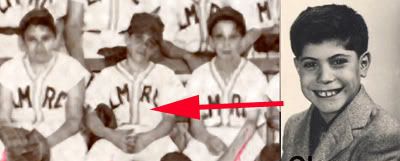
I think the impetus for Knickerbocker Village like blogs is a natural one. You reach a certain age and recognize your mortality. You remember a time when your life was relatively uncomplicated and trouble free and you want to return to it. You also want to bring your parents back to life by remembering those times, because more than likely they've passed on by that point. You never dream that many of the people you grew up with have already died. Yesterday in an attempt to find Glen Farber I used the tactic of searching for a relative's name, one who might have a much less common and easier one to track down. Unfortunately when I spoke to Glen's mother I found out that Glen passed away several years ago at 51. That's Glen above. My friend Marty wrote this after I shared the sad news:
He was very cool. In his iridescent raincoat flipping foul shots in one handed from the key, cigarette dripping from the side of his mouth at 14. Dapper and sarcastic but with a sweetness despite it all. He got kicked off the Corlear's basketball team because he wouldn't take orders from the coach. I said, "Yeah, but didn't you want to be on the team?" He said, "Sure, but nobody tells me what to do. that's all there is to it." And then he flipped the foul shot through the rim soundlessly, not touching anything but air in the middle of the basket. And then a little smirk. Peace to you my brother.
Where Or When: Dion
This was the number 21 hit in 1960. I really don't remember it, but the checker label is certainly familiar. I have to say that after the zenith of my "Nancy Bueller" days of 1958-9 I never had much interest in rock n' roll. I retreated into the world of my parents' music and WNEW-AM. It wasn't such a bad decision, except it started to be dominated by the drech of Ferrante and Teicher and 101 Strings and not the great Riddle arrangements of Sinatra and Ella. Eventually I found the logical path for myself by becoming a jazz fan when I reached college. What abut folk and protest music? I guess I needed to rebel against the rebellers
Wednesday, May 21, 2008
Where Or When 2
 from 9/5/06 from pseudo-intellectualism
from 9/5/06 from pseudo-intellectualism This time I matched the larger versions of some the matching Abbott and Levere sites along with the MCNY's text. "The matching New York scenes is nice school project. There are many archival images ready for the amateur to do his or her matching. It would also be an interesting project to take along enlarged old images to the site and do some interviewing of an on-site senior citizen as a prop to spark memories of that scene.
Where Or When
 Where Or When was my father's favorite song. It was his song of choice to sing at weddings and bar-mitzvahs along with At Last, The Nearness of You and Stardust. They were not easy songs to sing, because they required a pretty decent range. My father had a good voice, but range was a problem. I could usually tell within a few bars if my father would "make it." If he wasn't I would try to run for cover to avoid embarrassment:from 9/5/06 from pseudo-intellectualism
Where Or When was my father's favorite song. It was his song of choice to sing at weddings and bar-mitzvahs along with At Last, The Nearness of You and Stardust. They were not easy songs to sing, because they required a pretty decent range. My father had a good voice, but range was a problem. I could usually tell within a few bars if my father would "make it." If he wasn't I would try to run for cover to avoid embarrassment:from 9/5/06 from pseudo-intellectualism I stumbled across Douglas Levere's New York Changing site. It preceded the book he published last year on the topic: "Douglas Levere Revisits Berenice Abbott’s New York presents pairs of images by contemporary photographer Douglas Levere and world-renown photographer Berenice Abbott. Abbott’s iconic photographs, drawn from the MCNY's permanent collection, were taken in the 1930s and first published in her landmark book, Changing New York (1939). More than six decades later, Levere used the same camera Abbott had used and returned to the same locations at the same time of day and the same time of year. Indeed, he took on the role of detective as he successfully sought to understand and replicate every aspect of Abbott’s process. When seen side by side, these two remarkable bodies of work reveal much about the city and the nature of urban transformation. Perhaps more than anything else, these carefully crafted images powerfully suggest that in New York, the only constant is change." I included some of those matched pairs, set I thought somewhat appropriately to Rodger's and Hart's "Where Or When."This was a big favorite of my father's to sing at weddings and bar mitzvah's. There were a few times he actually pulled it off with some success. The version used is an abridged Benny Goodman one.
The amazing Hart lyrics, that capture the essence of Deja Vu, complete with the verse:
When you're awake, the things you think Come from the dream you dream
Thought has wings, and lots of things Are seldom what they seem
Sometimes you think you've lived before All that you live to day
Things you do come back to you As though they knew the way
Oh the tricks your mind can play
It seems we stood and talked like this, before We looked at each other in the same way then
But I can't remember where or when The clothes you're wearing are the clothes, you wore
The smile you are smiling you were smiling then But I can't remember where or when
Some things that happened for the first time Seem to be happenin' again
And so it seems that we have met before And laughed before, and loved before
But who knows where or when Some things that happened for the first time
Seem to be happenin' again And so it seems that we have met before
And laughed before, and loved before But who knows where or when
Greenpoint Greenery
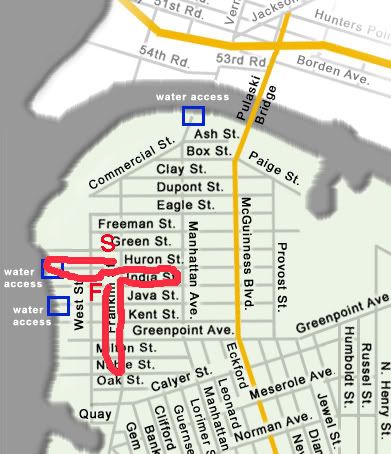 A Knickerbocker Village author celebrating his 59.5 year birthday joined me on a Greenpoint walking tour. Using information from Adrienne Onofri's Walking Brooklyn we traversed the path indicated. Highlight's included the view from the pier, the Astral Apartments, the Mechanics and Trader's Bank and great coffee and dessert at the Brooklyn Label.
A Knickerbocker Village author celebrating his 59.5 year birthday joined me on a Greenpoint walking tour. Using information from Adrienne Onofri's Walking Brooklyn we traversed the path indicated. Highlight's included the view from the pier, the Astral Apartments, the Mechanics and Trader's Bank and great coffee and dessert at the Brooklyn Label.from greenpunkt
A Short History of Greenpoint Brooklyn
In 1645 the streets of New Amsterdam, at the southern tip of Manhattan, were muddy and raucous with the sound of livestock and fowl. On a small path, north of town, young girls washed linen in a stream where today Maiden Lane crosses lower Manhattan. And, after three long years of bloody conflict with the Algonquin Indian tribe, a peace settlement had finally been achieved between the Indians and the Dutch Colony.
It was in that year (1645) that Dirck Volckertsen bought a peninsula of salt marsh, meadows and sandy beachline from the Dutch West India Company. Volckersten, known as “Dirck the Norman”, built a house atop a small knoll which stood just west of the present day intersection of Calyer and Franklin Streets. The house, as was typical of early Dutch settlements, bore the influences of contemporary Dutch architecture. Construction materials were limited, and so Dirck Volckersten took the stones from the fields, and the wood from a nearby forest to build the house.
By 1777, as the American Revolution raged, four new homesteads were built on the quiet and isolated land. Two homesteads were owned by brothers (Abraham and Jacob Meserole), while the other homes were owned by Jacob Bennett, Jonathan Provoost, and Jacobus Calyer. Each of these houses abutted a plot of farm land, and their harvests were brought by family boat to market at the southern end of Manhattan.
The landscape of the point, in these early years, was significantly different than it is today. Steep bluffs, some 100 feet tall, dropped into the East River between Java and Oak Streets. Just north of present day Huron Street, formed by the outflow of Newtown Creek, a scraggly point of marsh grass extended out into the river, giving the point its name. That point is now gone, as are the many streams, with fish and blue crabs, that drained the marshes and fed Newtown Creek.
Much of this change can be attributed to the arrival of Neziah Bliss, a resolute visionary. In 1834, after having purchased some 30 acres of land, Bliss had this southern portion of Greenpoint surveyed. Although surveyed for streets and lots, the first house was not constructed until late fall 1839. The interim between survey and construction might best be explained by the isolation of Greenpoint. Prior to the completion of what was named the Ravenswood, Green-Point and Hallet’s Cove turnpike, access to the land of Greenpoint was, at best, inconvenient. The turnpike ran along present day Franklin Avenue. As with the land survey, the turnpike was predominantly funded by Neziah Bliss.
Across the river, New York City was a burgeoning metropolis. Beginning in 1820, an enormous and overburdening influx of foreigners poured into the United States, and the preferred port of entry was New York Harbour. With the vast influx of foreigners, as well as a depression settling on the cities inhabitants, crime and poverty skyrocketed. By 1832, cholera joined the army of ills besetting Manhattan. Cholera was shortly followed by fire and insurection. It is of no surprise then, that following completion of the Ravenswood, Green-Point and Hallet’s Cove turnpike that Greenpoint's population rose rapidly.
With the opening of the turnpike in 1839, Neziah Bliss next set out to establish a ferry service between Greenpoint and Manhattan. Up to this point, all conveyeance between Greenpoint and New York City, was conducted on a system of privately owned skiffs. By 1848, Bliss had procured a lease from the City of New York, and by 1850 an established ferry system departed from the base of Greenpoint Avenue to 10th street on Manhattan.
Concurrent with the opening of the turnpike and the ferry service, the formerly isolated community of Greenpoint transformed into a center for shipbuilding and shipwrights. Shipbuilding facilities sprouted all along the Greenpoint waterfront, as did houses to house the shipwrights that worked in them. By 1850, twelve seperate shipyards lined the Greenpoint waterfront, employing thousands of workers.
In response to the turnpike, shipyards, and the influx of new inhabitants, the town of Greenpoint soon developed. In 1848 the first school of Greenpoint opened near Kent and Manhattan Avenue. The first general store opened on the turnpike (present day Franklin and Freeman streets) in 1850, with the installation of gasslights to the town in 1854. Saint Anthony's church, which stands as a kind of emblem of Greenpoint, was erected in 1874.
In 1862, the most famed of all the ships assembled in Greenpoint was launched from the Continental Iron Works yard (located at Calyer and West Street). This was the USS Monitor, the world's first ironclad, turreted warship, measuring 173' long and displacing over 900 tons. On March 9th, 1862 the USS Monitor engaged with the CSS Virginia in one of the most significant naval battles of the Civil War. Although niether side decisively won the battle, naval warfare was forever changed: the history of wooden warships had ended.
Other industries established themselves contemporaneous with the shipbuilding industry in Greenpoint, including printing, pottery, gas, glass, rope, pencil and iron manufacture and production. In 1867, the Astral Oil Works refinery was built (the Astral Apartments were later built to house its employees). Soon followed the American Manufacturing Company, with its interconnecting pedestrian bridges that still cross above West street today. In 1872, Faber Pencils also opened a factory in Greenpoint (between Greenpoint Avenue and Kent Street, on Franklin).
Although the Greenpoint shipbuilding industry declined following the Civil War, other industries remained, and bouyed its economy.
Who's Almost Who In Knickerbocker Village History: Annie Moore Schayer
The celebrated Annie Moore, the first immigrant of Ellis Island, lived at 99 Cherry Street and 32 Monroe Streets. This information was recently unearthed, disproving a myth as to her whereabouts after she passed through Ellis Island.
from the nytimes of 9/16/06
the information below comes mostly from genealogist's Megan Smolenyak Smolenyak web site
from the nytimes of 9/16/06
Four generations of descendants of Annie Moore Schayer, the first immigrant to be processed on Ellis Island, gathered yesterday in New York for the first time to celebrate her rediscovery — and their own — and to raise money for a headstone for her unmarked grave in Calvary Cemetery in Queens.
The first contributions, of $500 each, came from Brian G. Andersson, the city’s commissioner of records, and Patricia Somerstein of Long Beach, N.Y., Annie’s great-niece. They donated their share of a $1,000 reward they received from a professional genealogist. The genealogist had been seeking clues to support her suspicion that a woman who died in Texas in 1923 and had been embraced by history as the Ellis Island Annie Moore was somebody else entirely. It turns out the Texan Annie Moore was not an immigrant at all.
In fact, the Annie Moore who was 15 in 1892 when she came to the United States from County Cork, Ireland, never moved west. She lived the rest of her life within a few square blocks on Manhattan’s Lower East Side and died at 99 Cherry Street. One of her granddaughters lived in a public housing project in the neighborhood until her death in 2001.
The genealogist, Megan Smolenyak Smolenyak, was joined at the New York Genealogical and Biographical Society by about a dozen Moore descendants as well as the Irish consul general and representatives of the Tenement Museum, the National Park Service, the National Archives and the County Cork Association. Among the descendants who attended were Mrs. Somerstein’s brother, Michael Shulman, 49, of Chevy Chase, Md., an investment analyst; a great-granddaughter of Annie’s, Maureen Peterson, 61, of Ocean Grove, N.J.; Dr. Julia L. Devous, 41, another great-granddaughter, of Phoenix; and Dylan Donovan Krauss, 9 months old, of Derby, Conn., Annie’s great-great-great-great-grandson. “We knew it was the truth, but we couldn’t prove it,” Mrs. Peterson said. Annie married the son of a German-born baker at St. James Church on James Street in 1895. Her husband was identified as an engineer and salesman at the Fulton Fish Market. They had at least 11 children, 5 of whom survived to adulthood. Annie died of heart failure in 1924 at 47 and is buried with six of her children at the cemetery in Woodside, Queens, flanked by markers for a Maxwell and a Jimenez.
the information below comes mostly from genealogist's Megan Smolenyak Smolenyak web site
Read this doc on Scribd: Annie2
Who's Almost Who In Knickerbocker Village History: Lee Lok
 I've been using a new search technique to find KV related history within the NYTimes' archive. What I do is search using specific addresses with quotes, e.g. "40 Monroe Street." That turned up the above article. I asked one of my favorite classmates, Alison Lee (Shue), if she was related. She wasn't, but she is related to the following: Lee Lok. On page 2 of the pdf document I boxed his name (near the bottom)
I've been using a new search technique to find KV related history within the NYTimes' archive. What I do is search using specific addresses with quotes, e.g. "40 Monroe Street." That turned up the above article. I asked one of my favorite classmates, Alison Lee (Shue), if she was related. She wasn't, but she is related to the following: Lee Lok. On page 2 of the pdf document I boxed his name (near the bottom) Read this doc on Scribd: lee lok
Tuesday, May 20, 2008
Neal Hellman's KV West 60th Birthday
Music: "Amazing Grace" by Nickel Creek
Kind of makes one feel that someday there could be a west coast KV reunion.
I wonder if they know about cutting punchball out there? Neal wrote a special piece called Mezuzzah Blues for the occasion
Read this doc on Scribd: Mezuzzah Blues
Monroe Street Block Party: August 26, 1965
It was a Lindsey sponsored re-election event. Familiar KVer's and KV locale's mentioned include Renee Leder's father, Elmer, Moltisanti's Bakery, Ramos' Bar and Grill and Birnbaum's Kosher Meat Market. from the nytimes
Read this doc on Scribd: knicker-blockparty
More On Mazie And Who's Almost Who That Lived In Knickerbocker Village, Morton White
The following pages come from the introduction to his autobiography, "A Philosopher's Story." He mentions Mazie. White lived at 76 Madison Street! About the book and White from Amazon
A vivid tale of the author's journey from the Lower East Side of New York to some of the greatest centers of higher learning.
"A happily detailed chronicle of decades at the heights of American academe, teeming with shrewd observations about the stars of Ivy League intellectual life." -Carlin Romano, The Philadelphia Inquirer
"White's autobiography is a worthy addition to all collections, both for its insights into the world of university teaching and as a mirror held up to one corner of a turbulent century."-Library Journal
"Although a great many memoirs are being published these days, this autobiography by Morton White has special significance because professional philosophers seldom write their memoirs and, when they do, they rarely produce books as engaging as this one. . . . Indeed, White's autobiography should attract more attention among the educated public than any book written by an American philosopher in many years."-Peter H. Hare, SUNY
As historian of ideas and a philosopher, White is able to situate his life in the deeper and broader intellectual currents of his time, and therefore the story of his experiences at Columbia, Harvard, and the Institute for Advanced Study is a brilliantly conceived contribution to the history of American philosophy in the twentieth century. Readers concerned with the development of higher education will be fascinated by White's description of the struggles over religion at Harvard in the 1950s, while historians of urban life will be much interested in his vivid account of his boyhood on the Lower East Side of New York. And students of pragmatism will learn much about the twentieth-century attack on the distinction between analyt! ic and synthetic statements from a letter written to White by the Polish logician Alfred Tarski, and from the three-way correspondence of Nelson Goodman, W. V. Quine, and White reproduced in an appendix. The author's discussion of his contact with such influential thinkers as John Dewey, G. E. Moore, and Isaiah Berlin, and especially his extensive correspondence with Berlin, will further enhance the book's appeal to a broad audience. Indeed, White's autobiography should attract more attention among the educated public than any book written by an American philosopher in many years." -Peter H. Hare, SUNY Distinguished Service Professor of Philosophy and Editor, Transactions of the C. S. Peirce Society: A Quarterly Journal in American Philosophy.
About the Author
Morton White is Professor Emeritus at the Institute for Advanced Study in Princeton, New Jersey. Among his many well-known books are Social Thought in America (Viking, 1948), Foundations of Historical Knowledge (Harper & Row, 1965), Science and Sentiment in America (Oxford, 1972), and The Question of Free Will (Princeton, 1993).
Read this doc on Scribd: mortonwhite2
Mazie Phillips

I found the obituary of the legendary Mazie of KV. There's a chapter devoted to Mazie in Joseph Mitchell's, "Up In The Old Hotel"
Read this doc on Scribd: maizie
From Pike Street To West Of Pike's Peak
Subscribe to:
Posts (Atom)

